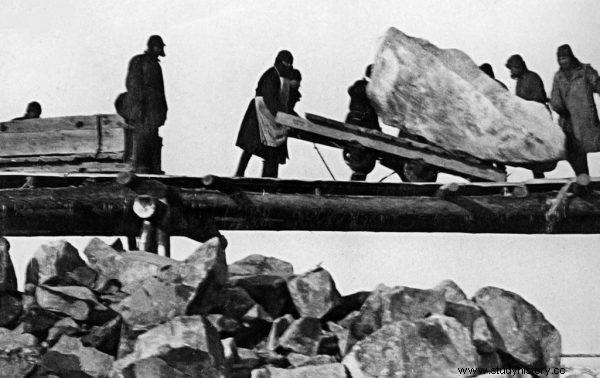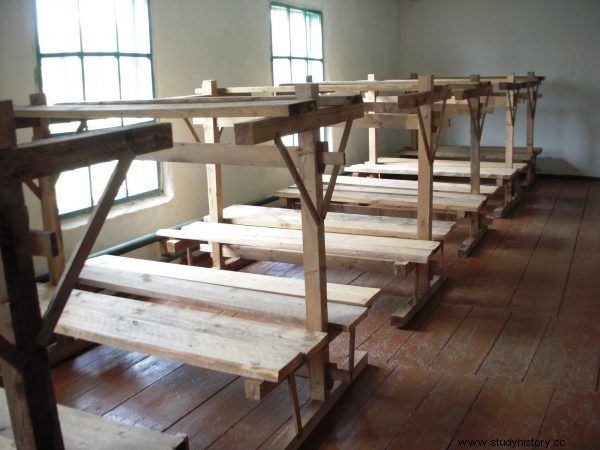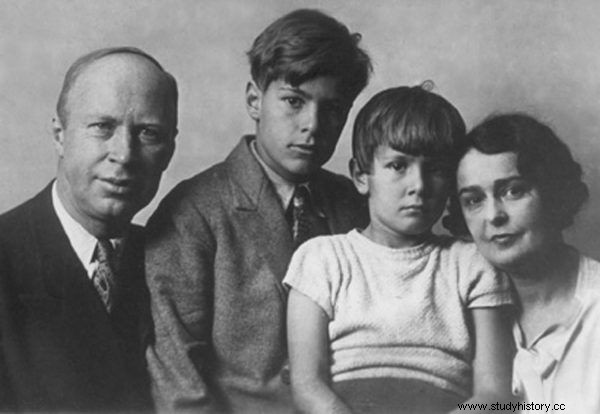They were forced to do work that the strongest men could not do. They suffered from hunger and the worst diseases. They were punished for the slightest offense. They were sexually abused, sometimes even daily. In order to survive, they agreed to compromise, which they remembered with disgust for the end of their days ... What exactly?
When Lina Prokofiev, the wife of the famous Russian composer and the heroine of Reyes Monforte's book "Russian Passion", crossed the gates of the labor camp, the guards did not give her more than half a year of life. On the second day after arriving at the camp, she was sent to work with other inmates. Its task was to collect rubbish from ice-bound roads and forest paths. The rope ran out of strength on the very first day. She hadn't met the standard, which meant she couldn't count on a full meal. The fact that she survived in the camp for several years is a miracle.
In Soviet labor camps, women were exposed to extreme humiliation and abuse. Therefore, in order to outsmart death, they resorted to every available survival strategy. They did not hesitate to steal, prostitute, cheat at work and even kill.
Anne Applebaum in the book "The Gulag" quotes the words of Galina Usakova:
I was a polite, well-mannered girl from an intellectual family. But with such features of the camp you will not survive - you have to harden, learn to lie and hypocrisy,
Tufta or self-harm
Slave labor in logging could weaken a woman's body within weeks. The camp standards were absurdly excessive, and the strength for work was diminishing every day. The female prisoners could not count on any reduced fare due to their gender. You can't, then die - this is how the ranger acknowledged the pleas of those who worked in the clearing of the forests.

Deported to the Gulags, both women and men, were forced to hard labor. The photo shows prisoners of Soviet camps at the construction site of the canal connecting the Baltic Sea with the White Sea.
Workers fell in the snow. Sometimes it was just fainting, sometimes they couldn't get up anymore. "Some female convicts froze at work, sometimes standing, bending over a wheelbarrow," says Elwira Watała, author of the book "Women around Stalin". That is why the convicts did what they could to get themselves a lighter job. However, if they hit a hard stretch, tufta saved them that is, the deceptions they learned from their more experienced companions of slavery.
Eugenia Ginzburg, the author of the memoirs of the labor camp "Steep Wall", with time mastered the art of making exorbitant standards in felling trees. She took advantage of the fact that the forest was full of pips left by previous teams of prisoners. There were so many of them that the guards did not count the whole thing. In order for those old trees to look fresh, it was enough to saw off a small piece of each log. In this way, the prisoners, instead of having to deal with cutting down new trees, simply refreshed the already prepared piles. They called it "refreshing sandwiches."
Self-mutilation was a much more drastic way of avoiding work. Ginzburg, who had been working as a nurse for some time, remembered a woman who had pierced her toe through with a large nail. The finger swollen and turned navy blue. The nail was stuck in the flesh, and the foul pus was collecting all around. The woman got a strong fever that threatened her life. Fortunately, not all attempts were so brutal. Less radical ways to simulate the disease were to put pollen into the eyes from a pencil or inject petroleum under the skin.
A demonstration of strength
Women imprisoned in labor camps often had to associate with ordinary criminals, thieves and prostitutes, i.e. the so-called urkaczkami or flatters. Urks, multiple recidivists, they ruled the camp and ordinary prisoners tried to get out of their way. However, this was not always possible. Sometimes there was a need for confrontation. Then, to emerge victorious, one had to fight the opponent with his own weapon.
Ginzburg remembers the first meeting with criminals on the ship on which she sailed to the labor camp. They took the women's bread, rummaged in their private belongings, pushed them away from better places. Until a certain prisoner hit one of them with all her strength in the jaw and threw a bunch of the worst curses at her . With this move, she gained the respect of the female urkers and saved a group of harassed fellow prisoners. In order to win in such a situation, it was not enough not to show fear. A demonstration of strength was needed.
Life in the camp taught ruthlessness. The enemies were shown no mercy, especially those who had any power over the prisoner. Olga Adamowa-Slozberg admits that she watched the impending death of the hated female officer in cold blood. She may have saved her life, but she has done nothing to help.

The photo shows a reconstruction of the prisoner interior of Perm-36. It was impossible to dream of any privacy in the camp.
This woman was known for her cruelty towards prisoners. She spent them, among others, in the hands of urk-rapists. Slozberg met her while working in the woods. The two women entered the stove shed where the workers were allowed to warm themselves for ten minutes. Suddenly the guard fell down on the bench - she had a heart attack. She was choking and banging her head on the floorboards, and her "ward" looked at it calmly.
In the meantime, another convict, a doctor by profession, entered the room and began to persuade Olga to save the dying woman. However, she refused. Why would she have a slight death? Let him tire him, ”she explained. Had it not been for a third party, the Ranger would have died in front of Slozberg. The prisoner admitted in her memoirs that she hated people who had brought her to such a state that she refused to help someone in a critical condition.
The prisoner Jefrosinia Kiersnowska, the author of the book "How much is a man worth", got an equally honest account. Driven to extremes, Kiersnowska grabbed the ax to kill the foreman who forced her sick friend to work in the forest. The tired woman, however, did not have enough strength to make a swing.

The complete Prokofiev family in the 1930s. Lina Prokofiev went to the Gulag for eight years.
How do I get a maintainer?
The drowning man catches on a razor - in camp conditions this proverb took on a particularly bitter meaning. Everyone had authority over the prisoners:functionary prisoners, guards, foremen, urks, and chiefs. Women usually had nothing to offer in return when they asked them for favors… except their own bodies. Giving back was sometimes the only way to get something done, for example to avoid being transferred to a camp where conditions were even worse.
Mira Jakowienko in "The Wife of the NKVD" describes the case of a prisoner, a former teacher, who spent the night with the camp chief. In this way, she wanted to avoid further transport. The next day it turned out that the governor had not kept his word. "And what does he need it for?" - comments Jakowienko - There will be another train, there will be a great choice again - clean, modest, intelligent women, those who would not even look at him at other times ".
However, we learn about prostitution in Soviet labor camps mainly from male accounts. Aleksander Sołżenicyn and Gustaw Herling-Grudziński, among others, write about him. The author of "Another World" described the shocking case of Marusia, who was raped by a gang of urks. The next day, still bruised and weakened, she sat down herself by the bunk of the dangerous criminal Kowal, the initiator of the rape. She started to make love to him.

The Gulag camp system stretched throughout the entire Soviet Union. The photo shows the place of deportation in the years 1923 - 1961.
It was her survival strategy. Knowing the strength and influence of urka, she wanted to ensure his protection against the omnipresent violence. Unfortunately, after some time the "lover" gave her to his brothers. In this world, women were the lower, despised beings whose main function was to meet men's needs.
Solzhenitsyn in the "Gulag Archipelago" mentions that almost every woman, especially if she was young and pretty, received an offer from potential "protectors". They were functionaries, urks, officers or simply more experienced prisoners. Many female backers have taken this "sensible step". As a result, they were assigned to lighter work under the roof, which increased their chances of surviving the camp.

Behind the camp fence was a Siberian landscape that killed any hope of escape.
For some women, having sex with a stranger was a one-time act of desperation. Solzhenitsyn cited the case of a starved and weakened Russian woman from the forest brigade who, out of hunger, gave herself to the cook. In return, she received a pan of fried potatoes with pork chop. Finally she vomited the entire meal.
I'll give bread for a drop of sperm
There was a moment when it seemed that the women were being offered an extra chance of liberation from the camp. There was a rumor that breastfeeding inmates would be allowed to return home. There were also those who were ready to give bread in exchange for a drop of sperm. They desperately wanted to get pregnant and have a baby - this was their chance for freedom.
When the rumor turned out to be false, the wave of abortions came. "The women stuffed themselves with nails and then sat down to work at the foot sewing machines, which caused severe hemorrhage," recalls Anna Andreyeva, quoted by Elwira Watala.
There are many reflections on morality in the camps in the memories of former backers. They are surprised that they enjoyed the extra slice of bread more than the letter from home. They admit that they had to learn to lie, if only to get a better job. They are surprised that they were able to grab an ax to kill. But is it possible to apply a "normal" measure to camp conditions? "Lagier was for a man a great test of the strength of character, ordinary human morality and ninety-nine percent of people did not stand this test" - wrote in "Kolyma Tales" Varlam Shalamov.
***
The article was inspired by Reyes Monforte's novel Russian passion (WAM Publishing House 2017).
Bibliography:
- Anne Applebaum, Gulag , trans. Jakub Urbański, Świat Książki 2013.
- Eugenia Ginzburg, Steep Wall , trans. Andrzej Mandalian, Czytelnik 1990.
- Gustaw Herling-Grudziński, Another world , Wydawnictwo Literackie 2010.
- Mira Jakowienko, The NKVD's wife. Confession of Agnessa Mironova , trans. Dorota Bal, Znak Horyzont 2014.
- Jefrosinia Kiersnowska, How much is a human worth , trans. Wiesława Karaczewska et al., Świat Książki 2012.
- Aleksander Solzhenitsyn, The Gulag Archipelago 1918-1958. An Attempted Literary Investigation , trans. Jerzy Pomianowski, Rebis 2015.
- Warłam Szalamov, Kolyma stories , trans. Juliusz Baczyński, Rebis 2016.
- Elwira Watała, Women around Stalin:lovers and convicts , Videograf 2014.
- Stories of women from the Gulag. The soul still hurts , Edited by Siemion Wileński, trans. Anna Kędziorek, PWN Publishing House 2011.
